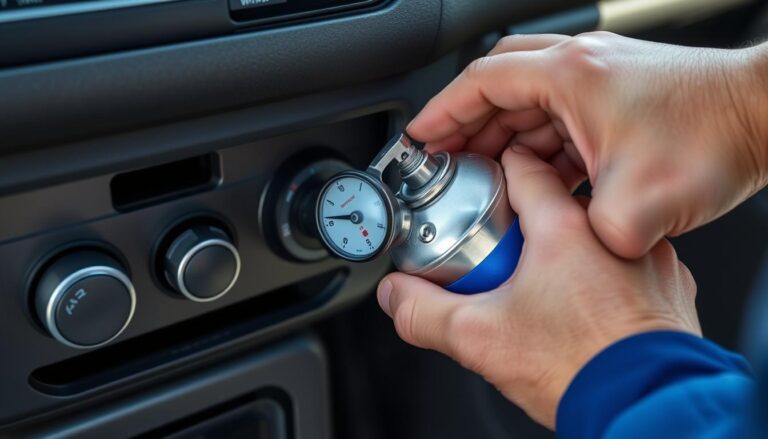The check engine light serves as a sentinel, alerting drivers to potential malfunctions within their vehicle’s systems. This illumination is a direct consequence of the onboard diagnostic system detecting anomalies, necessitating immediate attention.
Grasping the implications of the BMW Service Engine Soon Light and the appropriate corrective measures is paramount for preserving your vehicle’s operational efficacy and longevity.
This discourse aims to elucidate the essence of the check engine light and proffer strategies for rectification, ensuring a swift return to vehicular functionality.
Key Takeaways
- Understanding the check engine light and its significance.
- Common reasons for the check engine light to illuminate.
- Steps to diagnose and fix the issue.
- The importance of the onboard diagnostic system.
- Tips for maintaining your vehicle’s health.
Understanding BMW Warning Indicators
Grasping the nuances of the diverse warning lights on your BMW’s dashboard is paramount for preserving your vehicle’s integrity. These indicators are crafted to notify drivers of impending issues, averting the escalation of minor malfunctions into significant problems.
Difference Between Check Engine and Service Engine Soon Lights
The distinction between the check engine light and the Service Engine Soon Light is not merely cosmetic; it is a reflection of the urgency of the issue at hand. The check engine light heralds a critical problem, necessitating immediate intervention, often related to the engine or emissions system. On the other hand, the Service Engine Soon Light typically signals a less severe issue, such as a loose gas cap or a minor sensor malfunction. Notwithstanding, it can also herald more critical problems.

How BMW’s Onboard Diagnostic System Works
BMW’s onboard diagnostic system (OBD) represents a cutting-edge computer that scrutinizes various facets of your vehicle’s performance. It gathers data from a multitude of sensors, identifying issues such as emissions malfunctions, engine misfires, or sensor malfunctions. Upon detecting a problem, the OBD system illuminates the corresponding warning light on your dashboard, accompanied by a diagnostic trouble code accessible via a scan tool. This data is crucial for both mechanics and DIY enthusiasts, facilitating the identification of the underlying cause of the problem.
Common Causes of the BMW Service Engine Soon Light
The illumination of the BMW Service Engine Soon Light signifies a detection by the onboard diagnostic system of a problem within the vehicle. Various issues, encompassing the emissions system, fuel system, and sensor malfunctions, can precipitate this warning. These problems are indicative of potential performance degradation and necessitate prompt attention.
Emissions System Issues
Problems within the emissions system are a frequent cause of the Service Engine Soon Light’s activation. Faults such as a malfunctioning catalytic converter, issues with the exhaust gas recirculation (EGR) valve, or failures in the evaporative emission control (EVAP) system can occur. These components are vital for emissions reduction, and their dysfunction can result in diminished vehicle performance and increased environmental pollution.
Fuel System Problems
Fuel system malfunctions are another prevalent reason for the Service Engine Soon Light’s illumination. Issues such as a faulty fuel injector, a clogged fuel filter, or a malfunctioning fuel pump can impede engine performance and prompt the warning light’s activation.
Sensor Malfunctions
Sensor malfunctions can also contribute to the illumination of the Service Engine Soon Light. Two critical sensors that can cause issues are the oxygen sensor and the mass airflow sensor.
Oxygen Sensor Failures
A faulty oxygen sensor can provide incorrect data to the engine control module, leading to poor engine performance and potentially causing the Service Engine Soon Light to illuminate. Common symptoms include decreased fuel efficiency and rough idling.
Mass Airflow Sensor Issues
The mass airflow sensor measures the amount of air entering the engine. A malfunctioning mass airflow sensor can cause the engine to run rich or lean, resulting in decreased performance and potentially triggering the warning light. Symptoms may include hesitation during acceleration or a rough engine idle.

Understanding these common causes can help BMW owners identify and address potential issues, ensuring their vehicle runs efficiently and safely.
Case Study: 2018 BMW 3 Series with Illuminated Warning Light
A 2018 BMW 3 Series driver encountered the Service Engine Soon Light on their dashboard, prompting a diagnostic investigation. This scenario offers profound insights into the diagnostic process. It underscores the significance of vehicle history and maintenance records in such instances.
Initial Symptoms and Driver Experience
The driver observed the illuminated warning light while driving on the highway, without any immediate performance anomalies. The light’s persistence, coupled with the driver’s concern, necessitated further investigation to uncover the underlying cause.
Vehicle History and Maintenance Record
The 2018 BMW 3 Series maintained a consistent maintenance schedule, adhering to the manufacturer’s recommendations. Its maintenance history revealed no significant issues prior to the illumination of the warning light, indicating proper upkeep.
Owner’s Initial Response
The owner’s first step was to scrutinize the dashboard for additional warnings and consult the owner’s manual. Failing to find immediate solutions, the owner sought professional mechanical expertise. This action underscores the critical role of expert advice in addressing unexpected vehicle malfunctions.
Diagnostic Process for BMW Warning Lights
The diagnostic process for BMW warning lights necessitates the employment of both professional diagnostic tools and DIY methodologies. Upon illumination of a warning light on your BMW’s dashboard, it is imperative to discern the underlying cause to enact the requisite corrective measures.
Professional Diagnostic Tools Used in Our Case Study
In our case study, the utilization of professional diagnostic tools was instrumental in uncovering the root cause of the illuminated warning light. The BMW ISTA/D diagnostic software, among others, facilitated communication with the vehicle’s onboard computer, enabling the retrieval of detailed error codes and system data.
A comparative analysis of various professional diagnostic tools is presented in the table below:
| Diagnostic Tool | Features | Compatibility |
|---|---|---|
| BMW ISTA/D | Advanced coding, programming, and diagnostics | BMW models from 1994 onwards |
| Autel MaxiSys | Bi-directional control, coding, and advanced diagnostics | Multiple car brands, including BMW |
DIY Options for Reading BMW Codes
For those inclined towards a DIY approach, tools such as the OBDLink MX+ can be employed to read BMW-specific error codes. These tools interface with the vehicle’s OBD-II port, offering valuable insights into the vehicle’s status.
“Utilizing the appropriate diagnostic tools can substantially diminish the time and expense associated with repairing your BMW.” –
Interpreting BMW-Specific Error Codes
Deciphering the error codes obtained from diagnostic tools demands a comprehensive understanding of BMW’s specific coding system. These codes span from generic OBD-II codes to manufacturer-specific codes unique to BMW.
By comprehending the diagnostic process and employing the correct tools, BMW owners can effectively diagnose and rectify warning light issues, ensuring their vehicle operates smoothly and efficiently.
Our Case Study Findings: Root Cause Analysis
Through an exhaustive analysis, we unearthed the fundamental causes behind the illuminated warning light on the 2018 BMW 3 Series. Our investigation entailed a meticulous examination of the vehicle’s systems and maintenance history to pinpoint the underlying issues.
Identified Issues in the Case Vehicle
The analysis revealed that the primary cause of the Service Engine Soon Light illumination was a faulty oxygen sensor. This malfunction led to inaccurate readings being sent to the engine control module, resulting in improper fuel-to-air mixture adjustments.
Contributing Factors
Further investigation showed that the faulty oxygen sensor was likely due to wear and tear over time, compounded by a lack of regular maintenance checks. “Neglecting regular maintenance can lead to premature component failure,” highlighting the importance of adhering to recommended service intervals.
Correlation with Maintenance History
A review of the vehicle’s maintenance history indicated that the last oxygen sensor replacement was performed over 50,000 miles prior. This correlated with the driver’s report of noticing decreased fuel efficiency and performance issues around the same time the warning light appeared.
The findings underscore the significance of regular maintenance in preventing and diagnosing issues that may trigger warning lights on BMW vehicles.
How to Fix BMW Service Engine Soon Light Issues
Addressing the BMW Service Engine Soon Light necessitates a meticulous diagnostic and repair strategy. Initially, one must identify the potential causes, which span from simple issues like loose gas caps to intricate engine malfunctions.
DIY Solutions for Minor Problems
For less severe problems, self-assisted remedies can prove efficacious. A straightforward check of the gas cap’s tightness can often rectify the situation. Further, employing a code reader to uncover the root cause offers indispensable information regarding the light’s activation.
When to Seek Professional Help
Should DIY efforts fail to alleviate the issue, professional intervention becomes imperative. Complicated problems, such as malfunctioning oxygen sensors, catalytic converter failures, or engine misfires, demand specialized equipment and technical acumen.
Cost Expectations for Common Repairs
Repair costs exhibit considerable variability based on the specific problem. For instance, the replacement of an oxygen sensor typically falls within the $200-$500 bracket, whereas addressing a catalytic converter malfunction can escalate to $500-$1,500 or even higher.
| Repair | Cost Range |
|---|---|
| Oxygen Sensor Replacement | $200-$500 |
| Catalytic Converter Replacement | $500-$1,500 |
| Gas Cap Replacement | $20-$50 |
Our Case Study Resolution
In our case study, a 2018 BMW 3 Series presented with an illuminated Service Engine Soon Light, attributed to a faulty oxygen sensor. Utilizing professional diagnostic tools, the sensor was successfully replaced, thus resolving the issue. The total expenditure for the repair stood at $350, encompassing both labor and parts.
Preventative Maintenance to Avoid Future Warning Lights
BMW proprietors can markedly diminish the probability of warning lights by embracing a preemptive maintenance ethos. This entails grasping and adhering to stipulated service intervals, vigilantly monitoring pivotal components, and contemplating long-term ownership considerations.
Service Intervals
BMW advocates for precise service intervals, contingent upon the model and year of the vehicle. Typically, BMWs necessitate oil changes every 5,000 to 7,500 miles, tire rotations every 5,000 to 8,000 miles, and brake pad replacements between 30,000 to 50,000 miles.
Critical Components
Components of paramount importance that necessitate consistent surveillance include the engine oil level, tire pressure, brake pads, and spark plugs. Disregard for these components can precipitate premature deterioration and potentially activate warning lights.
Long-term Considerations
For extended ownership, maintaining a meticulous maintenance log, addressing concerns expeditiously, and contemplating the upgrade to high-performance components is crucial. This anticipatory strategy can enhance the vehicle’s longevity and diminish the frequency of warning lights.
| Maintenance Task | Interval | Importance |
|---|---|---|
| Oil Change | 5,000 – 7,500 miles | High |
| Tire Rotation | 5,000 – 8,000 miles | Medium |
| Brake Pad Replacement | 30,000 – 50,000 miles | High |
Understanding the Importance of BMW Service Engine Soon Light
The BMW Service Engine Soon Light serves as a critical warning indicator, signaling potential malfunctions within your vehicle. Through our comprehensive case study and analysis, it is evident that grasping the significance of this light and the diagnostic process is paramount for preserving your BMW’s performance and longevity.
By identifying the root causes of the illuminated warning light and acting swiftly, you can avert minor issues from escalating into major problems. The role of regular preventative maintenance, as previously discussed, is instrumental in circumventing future warning lights and ensuring your BMW operates at peak efficiency.
In conclusion, being well-versed in your BMW’s warning indicators and taking proactive measures can significantly reduce both time and financial expenditures in the long term. By integrating this knowledge with the diagnostic process, you will be adequately prepared to address any emerging issues, thus maintaining your vehicle in its optimal state.
FAQ
What does the BMW Service Engine Soon Light indicate?
The BMW Service Engine Soon Light serves as a warning indicator, signaling a potential issue with the vehicle’s engine or emissions system. It prompts the driver to have the vehicle inspected by a professional.
How is the BMW Service Engine Soon Light different from the Check Engine Light?
The BMW Service Engine Soon Light and the Check Engine Light both indicate vehicle issues. The Check Engine Light signifies more critical problems requiring immediate attention. In contrast, the Service Engine Soon Light may indicate a less urgent issue that still necessitates attention.
Can I continue driving my BMW with the Service Engine Soon Light on?
It is advisable to have the vehicle inspected as soon as possible. Generally, it is safe to continue driving for a short period. Ignoring the light for an extended time, though, can lead to more severe problems.
What are some common causes of the BMW Service Engine Soon Light?
Common causes include emissions system issues, fuel system problems, and sensor malfunctions. These can include oxygen sensor failures or mass airflow sensor issues.
How can I diagnose the issue causing the BMW Service Engine Soon Light?
You can employ DIY diagnostic tools to read BMW codes. Alternately, consulting a professional mechanic who can utilize specialized diagnostic equipment is advisable to identify the root cause of the issue.
What are the cost expectations for repairs related to the BMW Service Engine Soon Light?
Repair costs vary widely based on the underlying issue. They range from relatively inexpensive fixes, such as replacing a faulty sensor, to more costly repairs involving major engine or emissions system components.
How can I prevent the BMW Service Engine Soon Light from coming on in the future?
Regular maintenance is key. Adhering to recommended service intervals, monitoring critical components, and addressing any issues promptly can help minimize the likelihood of the light illuminating.
Is it necessary to reset the BMW Service Engine Soon Light after repairs?
In most cases, the light will automatically turn off after the issue is resolved. In some instances, manual resetting using a diagnostic tool may be necessary.


